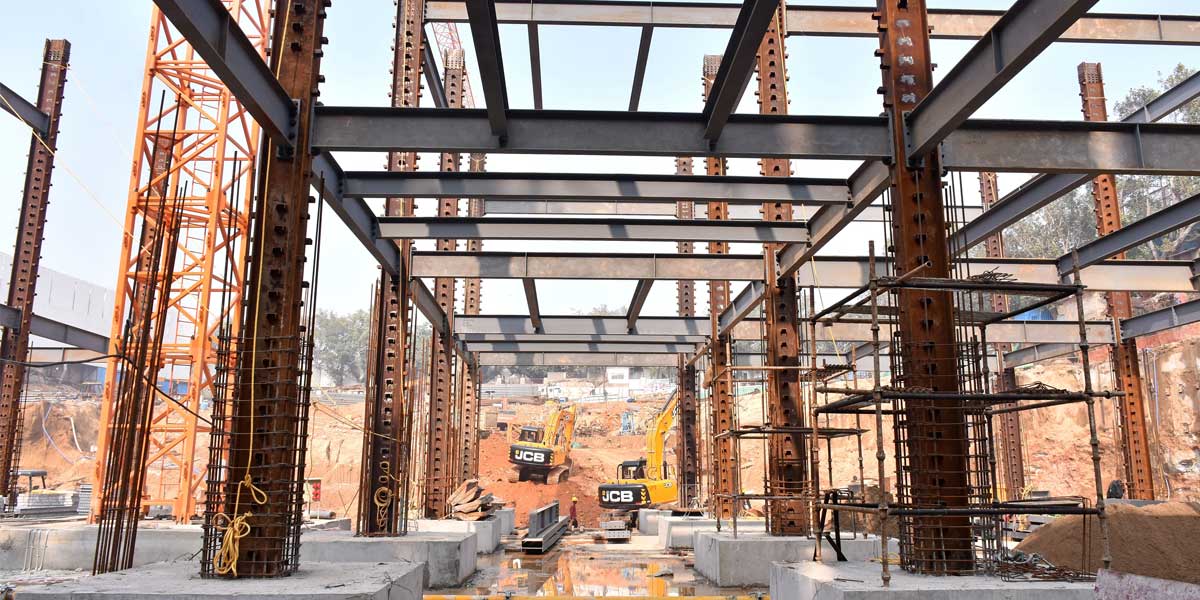

India is the third largest consumer of steel in the world. There has been a growing preference for structural steel in the real-estate and construction sectors in the past few years owing to the evolving design of projects and the need to finish projects at a fast pace.
Kolkata-based Eden Realty’s upcoming projects are mostly G+12 to G+30 storeyed towers. “The taller the buildings, the greater the steel consumption in the towers,” says Kumar Satyaki, Joint Managing Director, Eden Realty. He adds that in high-rise buildings, aluminium formwork is the most suitable technology for speed and quality, which further increases steel consumption. “Also, for some of the more ambitious and innovative designs in clubhouses or some commercial buildings, we often opt for structural steel structures over RCC structures.”
New Delhi-based Omaxe is using a modular steel structure, sourced from JSPL, in the construction of its upcoming multilevel parking-cum-commercial project, Omaxe Chowk, in Chandni Chowk, Delhi. Jatin Goel, Executive Director, Omaxe, says, “Besides expediting construction and reducing project cycle time, this technology provides us with a lot of flexibility and more usable space to end-users.” He confirms that the company will be using structural steel in the construction of its future projects as well.
Risks like a price rise have been factored in by Omaxe so as not to affect the construction timeline or increase in property prices. For Omaxe Chowk, the company ordered 7,000-8,000 mt of structural steel in knocked-down form from JSPL under an agreement signed in July 2020. “We have started receiving the supplies at site and installation is currently under progress on all three basements,” confirms Goel. “The supplies will come in a phased manner to meet the construction schedule.”
For Eden Realty, the impact has drastically been felt on its affordable housing projects. Satyaki explains, “We have stringent margins and steel constitutes almost 18 per cent of our raw construction costs.” Increase in steel prices has been more than 50 per cent over the past six months, which has not left any margins. “We are hoping for prices to reduce in the near future or we may be forced to increase our flat prices in coming months, which is not desirable in affordable housing. Luckily, we have not faced availability challenges yet; this would have further affected our projects in terms of timeline and affordability.”
Also, as there are only a few producers of high-grade structural steel (450MPa) in India, Goel says, “There is often a demand-supply mismatch, affecting both availability and prices considering the huge construction activity going on in the country at any point of time.” For Omaxe Chowk, the company has ensured constant supply and pricing throughout the tenure of the agreement so as not to interrupt construction activity and thereby avoid any delay in the project’s delivery, which is scheduled in July 2022.
“There is a definite and ever-rising demand of structural steel; therefore, steel producers must brace for this demand, especially in higher grade steel,” says Goel. He also agrees that high steel prices are making infrastructure projects unviable. “Recently, Union Road Transport Minister Nitin Gadkari also discussed the issue of rising prices and cartelisation with the Prime Minister and the PMO, and called for regulating the sector. To achieve the Prime Minister’s dream of making India a $ 5 trillion economy, the infrastructure sector, including steel and cement players, must work in tandem.”
- SHRIYAL SETHUMADHAVAN